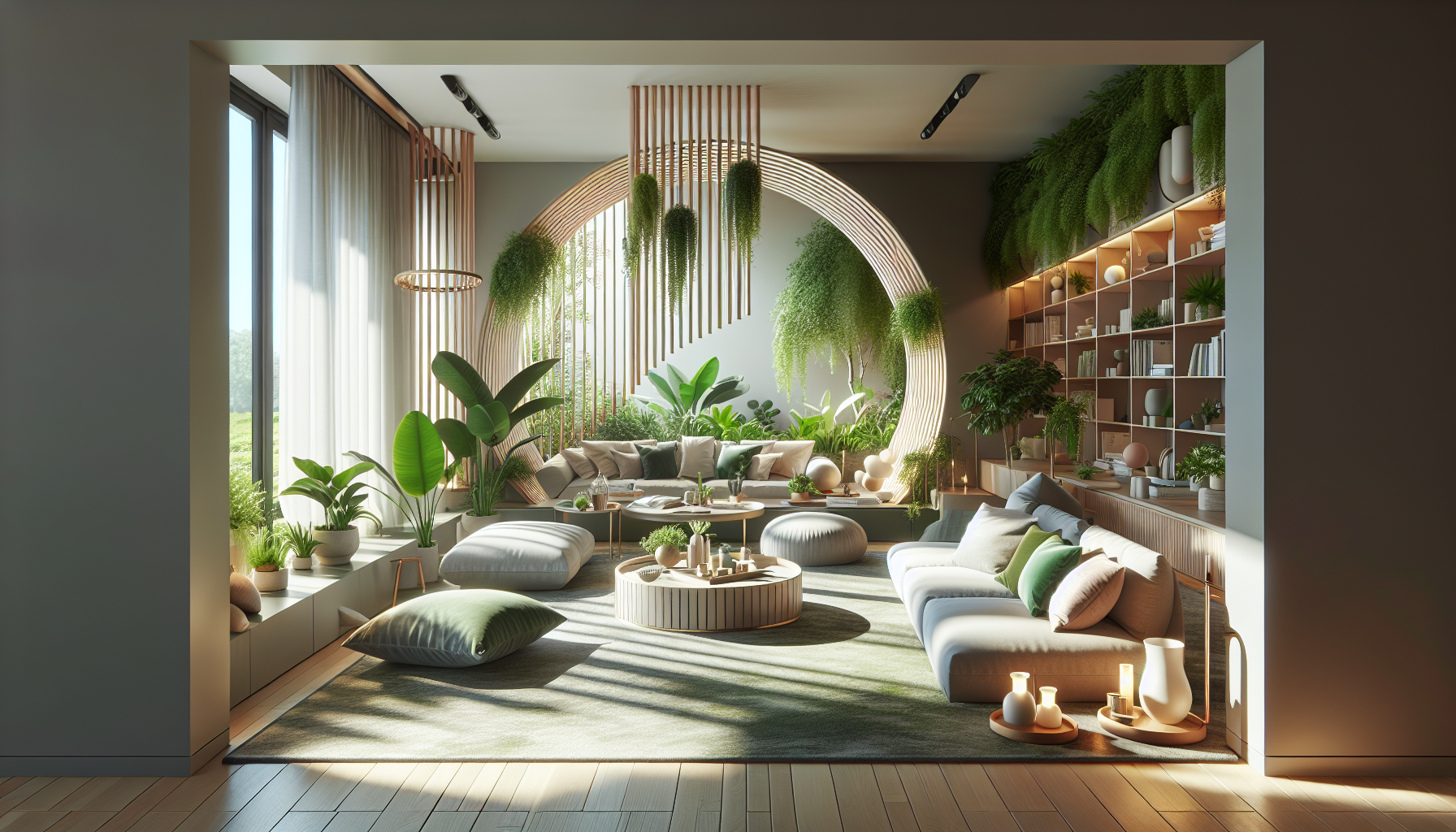In the hustle and bustle of our daily lives, the spaces we inhabit often become reflections of our inner chaos. Our homes, meant to be sanctuaries of tranquility and personal expression, can easily transform into cluttered mazes that drain our energy rather than rejuvenate it. But what if the key to unlocking a more balanced and energized life lay not in an elaborate renovation or an expensive redecorating spree, but rather in the simple art of furniture placement? Welcome to a transformative journey that explores the profound impact of arranging your living space to enhance the flow of energy, creating a harmonious environment that nourishes both body and soul. 🏡✨
At the heart of this exploration lies the ancient practice of Feng Shui, a philosophy that has been guiding people for centuries in aligning their surroundings with their personal energy fields. But this is not just about tradition or spirituality; modern science increasingly acknowledges the psychological effects of our physical environments on well-being. This article will delve into the principles behind optimal furniture placement, drawing from both time-honored wisdom and contemporary research to offer practical, actionable advice. We will explore how different arrangements can alter the atmosphere of a room, influence your mood, and even impact interpersonal relationships. From the commanding position of a bed in the bedroom to the social dynamics of a living room seating plan, every choice contributes to the invisible energy currents that shape our experiences.
Prepare to discover not only the aesthetics of harmonious interiors but also the profound ways in which your home can support your mental and emotional health. We will guide you through common pitfalls, such as overcrowding and poor orientation, and reveal strategies to create spaces that breathe, flow, and inspire. Whether you’re seeking to enhance productivity in your home office, cultivate peace in your bedroom, or foster connection in communal areas, the power of mindful furniture placement can transform your living environment—and, by extension, your life. As you embark on this journey, envision your home not merely as a physical structure, but as a dynamic partner in your quest for balance and joy.
The Psychology Behind Furniture Placement
Furniture placement is often underestimated in its power to affect not just the aesthetic appeal of a space, but also the emotional and psychological well-being of those who inhabit it. When we enter a room, our subconscious immediately reacts to the arrangement and positioning of furniture. This reaction is deeply rooted in human psychology and can influence our mood, productivity, and overall sense of well-being. The concept of space and how we occupy it has always been central to human culture, and the way furniture is arranged plays a pivotal role in this dynamic.
Studies have shown that cluttered or disorganized spaces can lead to feelings of stress and anxiety. Conversely, well-organized and thoughtfully arranged spaces can promote a sense of calm and order. This is because our brains are hardwired to seek out patterns and organization; when these elements are absent, it can create a sense of dissonance. The strategic placement of furniture can help create balance and harmony in a room, which in turn can lead to increased feelings of happiness and relaxation.
Moreover, furniture placement can also impact social interactions and relationships. A room that is arranged in a way that facilitates conversation and connection can enhance the quality of interactions between people. For instance, placing chairs and sofas facing each other rather than away can encourage eye contact and more engaging dialogue. In this sense, the arrangement of furniture is not just a matter of aesthetics but also a tool for enhancing social and emotional connections.
Understanding Energy Flow in Your Space
The concept of energy flow, often referred to as “Chi” in Feng Shui, is integral to understanding how furniture placement can affect your space. According to this ancient Chinese practice, the way energy flows through a room can impact the health, wealth, and happiness of its occupants. By optimizing the flow of energy, one can create a more harmonious and balanced environment.
One of the key principles of Feng Shui is to avoid blocking pathways with furniture. This allows energy to move freely throughout the space, which can help to invigorate the room and its occupants. Sharp angles and clutter should be minimized as they can disrupt the flow of energy and create areas of stagnation. Instead, aim for smooth, flowing lines and open spaces that encourage movement and fluidity.
Another important aspect of energy flow is the orientation of furniture. For example, placing a bed in line with the door can lead to poor energy flow, as it is believed that energy can rush into the room and disrupt sleep. Instead, position the bed diagonally from the door to create a more tranquil and restful environment. Similarly, desks should be placed in a commanding position where the individual can see the door, which can enhance focus and productivity.
Practical Tips for Effective Furniture Placement
Applying these principles in your home doesn’t require a complete overhaul. With a few strategic changes, you can significantly alter the energy flow and functionality of your space. Begin by assessing the room’s purpose and the needs of its occupants. Is the space meant for relaxation, socializing, or working? Each function has its own requirements when it comes to furniture placement.
For living rooms, consider creating distinct areas for conversation and relaxation. A sofa can anchor a conversation area, while a comfortable chair in a corner might serve as a reading nook. Use rugs to define these spaces and help guide the flow of energy. In dining rooms, the table should be the focal point, with chairs arranged in a way that promotes easy interaction. Ensure there is ample space to move around the table without obstruction.
In bedrooms, prioritize comfort and relaxation. The bed should be the main focus, ideally positioned against a solid wall and away from the door. Nightstands on either side of the bed can provide balance and symmetry. For home offices, arrange the desk to face the entrance, which is known as the “command position” and is believed to enhance productivity and control.
Common Mistakes to Avoid
Even with the best intentions, certain mistakes in furniture placement can undermine your efforts to create a harmonious space. One common error is overcrowding. While it may be tempting to fill a room with furniture, doing so can lead to a cramped and chaotic environment. Instead, embrace the principle of “less is more” and opt for quality pieces that serve multiple functions.
Another mistake is ignoring scale and proportion. A large sofa in a small room can overwhelm the space, while tiny furniture in a large room can feel lost. Balance is key; choose furniture that fits the scale of the room and complements other pieces. Additionally, avoid pushing all furniture against the walls. This can make a room feel cold and unwelcoming. Instead, bring furniture inwards to create intimate and inviting spaces.
Lighting is another crucial aspect that is often overlooked. Proper lighting can enhance the overall feel of a room and highlight its best features. Use a combination of ambient, task, and accent lighting to create a layered effect. Don’t rely solely on overhead lights; incorporate lamps and wall sconces to add warmth and depth.
Comparative Table: Traditional vs. Modern Furniture Placement Strategies
Understanding the differences between traditional and modern approaches to furniture placement can help you decide which strategy aligns best with your space and lifestyle. Traditional methods often emphasize symmetry and formality, while modern techniques focus on flexibility and functionality.
| Aspect | Traditional Furniture Placement | Modern Furniture Placement |
|---|---|---|
| Focus | Symmetry and balance | Functionality and flow |
| Layout | Formal and structured | Open and flexible |
| Furniture Arrangement | Against walls | Centered and grouped |
| Color Scheme | Neutral and classic | Bold and varied |
| Lighting | Central fixtures | Layered lighting |
For a deeper dive into furniture placement strategies, watch this insightful video on modern design techniques from the ‘Home Improvement’ channel.

Conclusion
Transform Your Space: The Power of Furniture Placement on Shifting Your Energy Field
In our exploration of the profound effects of furniture placement on our personal energy fields, we’ve journeyed through the intricate interplay between physical environments and emotional well-being. This topic, at the intersection of interior design and holistic wellness, sheds light on how consciously curating our living spaces can lead to transformative changes in our lives. By understanding and applying principles from disciplines such as Feng Shui and environmental psychology, we can create atmospheres that not only look aesthetically pleasing but also resonate positively with our inner selves.
Throughout this article, we’ve delved into several critical themes. We began by discussing the concept of energy fields, how they are influenced by our surroundings, and the importance of aligning these energies to foster harmony and balance in our daily lives. This foundation set the stage for understanding how furniture placement acts as a conduit for energy flow within a space, impacting our mood, productivity, and overall sense of peace.
Next, we examined practical strategies for optimizing furniture placement. We highlighted the significance of flow and circulation, emphasizing the need for clear pathways that allow energy to move freely. This is akin to ensuring that the layout of our homes and workspaces supports rather than hinders our natural movements, which can significantly affect our comfort and efficiency. Concepts such as the commanding position, which suggests placing key pieces of furniture like beds and desks in spots where one can see the door without being directly in line with it, were introduced as vital tools in this process.
The article also underscored the psychological and emotional impacts of different furniture arrangements. By strategically positioning furniture to foster interactions, we create spaces that encourage communication and connection. Similarly, arranging furniture to maximize natural light not only enhances the aesthetic appeal of a room but also has been shown to boost mood and mental clarity. These considerations are essential for cultivating an environment that supports mental and emotional health.
Furthermore, we touched upon the importance of personalization and authenticity in furniture placement. While guidelines and principles provide a helpful framework, it is crucial to adapt these to our personal tastes and lifestyles. A space that truly reflects who we are can amplify positive energy and make us feel more at home, reinforcing our identity and aspirations. This section encouraged readers to blend creativity with intentionality, crafting spaces that are both functional and uniquely theirs.
The transformative power of furniture placement lies in its ability to shift the energy within a space, turning ordinary rooms into sanctuaries of tranquility and inspiration. By mindfully arranging our environments, we can influence our emotions, behaviors, and even interpersonal relationships. This process of transformation is not merely about aesthetics; it is about creating a supportive backdrop for our lives, one that nurtures growth and well-being.
As we conclude this exploration, it is essential to recognize the broader implications of these insights. In an increasingly fast-paced and stressful world, our homes and workplaces can serve as vital havens of peace and rejuvenation. By taking control of our environments, we empower ourselves to live more intentionally and harmoniously. This empowerment extends beyond the physical realm, inspiring us to make conscious choices in other aspects of our lives.
I encourage you, the reader, to reflect on your own spaces and consider how you might apply these principles. Whether it’s rearranging your living room to improve energy flow or creating a cozy nook for relaxation, small changes can have a profound impact. Engage with this content by sharing your experiences or ideas in the comments below. Let this be a starting point for a community dialogue on how we can all create spaces that uplift and energize us.
Furthermore, share this article with friends and family who might benefit from a fresh perspective on their living spaces. Together, we can foster a greater appreciation for the role our environments play in shaping our lives. By spreading awareness, we contribute to a collective movement towards more thoughtful and intentional living.
In closing, remember that transforming your space is not a one-time event but a continuous journey. As our lives evolve, so too should our environments. Stay curious, be open to change, and embrace the power of furniture placement as a tool for personal growth and well-being. Let’s create spaces that not only reflect who we are but also inspire us to become the best versions of ourselves. 🌿✨
For further reading and resources on this topic, consider exploring reputable sources such as the International Feng Shui Guild (https://www.ifsguild.org) and the Environmental Design Research Association (https://www.edra.org). These platforms offer a wealth of information to deepen your understanding and practice of mindful design.
Toni Santos is a visual storyteller and conceptual archivist whose work explores the curious, often poetic ruins of pseudoscience and obsolete theories. With a reverence for forgotten frameworks and fantastical logic, Toni illuminates the imaginative spaces where science once drifted into myth, speculation, and symbolic belief.
His creative path is rooted in a fascination with the fringe — from phrenology maps to ether diagrams, hollow earth charts to animal magnetism illustrations. Each visual Toni creates or curates is an invitation to reexamine the strange beauty of discarded knowledge — not as failure, but as cultural reflection, as art born from our eternal desire to explain the unexplainable.
Blending visual design with historical inquiry, Toni gives new life to lost diagrams, metaphysical charts, and antique engravings that once shaped worldviews. His work occupies the liminal zone between fact and fiction, where obsolete models still pulse with philosophical resonance and forgotten charm.
As the mind behind Vizovex, Toni shares illustrated essays, curated collections, and visual reinterpretations that invite others to explore the aesthetic and symbolic value of outdated theories. His goal is not to validate, but to remember — to view these speculative systems as relics of human creativity, vulnerability, and yearning.
His work is a tribute to:
The elegance of error in the evolution of knowledge
The symbolic artistry of discarded explanations
The blurred lines between belief, observation, and imagination
Whether you’re a collector of curious ideas, a lover of forgotten diagrams, or someone drawn to the strange scaffolding of old worldviews, Toni opens a portal to a time when the universe was still full of ghosts, humors, and cosmic fluids — one chart, one symbol, one discredited wonder at a time.





